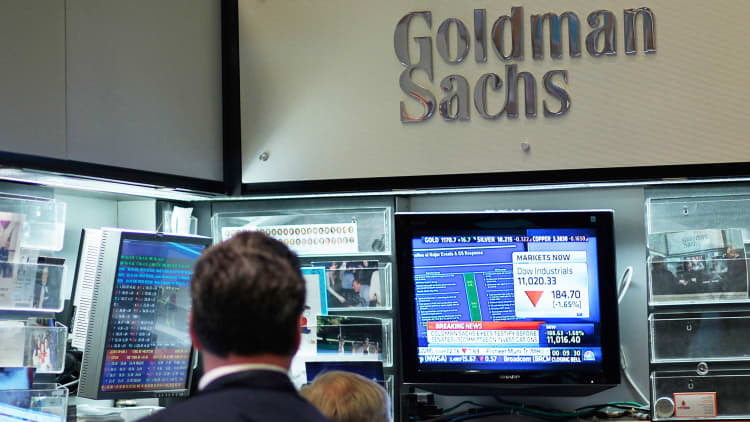
Goldman Sachs reported first-quarter results that beat significantly on both the top and bottom line as the bank's traders took advantage of a volatile stock market, posting the highest equities trading revenue in three years.
Here's what the bank reported compared to what analysts polled by Thomson Reuters were expecting:
— Revenues of $10.04 billion versus expectations of $8.74 billion.
— Earnings per share of $6.95 versus expectations of $5.58.
Goldman also raised its quarterly dividend 5 cents to 80 cents per common share.
The bank's CEO Lloyd Blankfein will be interviewed on CNBC Wednesday morning, at 8:30 a.m. ET.
Revenue from equities trading surged 38 percent to $2.31 billion, trouncing the $1.92 billion consensus analyst estimate from FactSet. The bank pointed to higher fees, high market volatility and more client activity compared to the last quarter of 2017 as reasons for the better results.
The S&P 500 fell into correction territory in February on fears over rising interest rates. The stock market has remained volatile since then as Wall Street weighs a brewing trade battle between the U.S. and China.
The bank reported fixed income, currencies, and commodities trading revenues of $2.07 billion, which was slightly below the $2.13 billion consensus analyst estimate from FactSet. Goldman said lower net revenues in interest rate products and mortgages affected results. Still, the figure marked a 23 percent increase from a year earlier and was also the highest quarterly result in three years.
The bank reported a 34 percent decline in trading revenue in the fourth quarter, raising pressure for Goldman to deliver in the first quarter, which it largely did. In the past, the premiere Wall Street bank has lagged its peers in trading.
"Solid performance across our businesses produced strong returns in the first quarter," Goldman Sachs CEO Lloyd Blankfein said in a statement. "We are well positioned to serve our clients as the global economy continues to show strength and central banks unwind certain aspects of policy stimulus."
Shares of Goldman closed 1.65 percent lower, after initially gaining.
Revenues from investing and lending rose 43 percent to $2.09 billion, beating the $1.46 billion consensus analyst estimate from FactSet. On a quarterly basis, that number rose 26 percent. Higher net revenues from initial public offerings also helped boost underwriting revenues 27 percent to $1.21 billion.
On the earnings call, Goldman's Chief Financial Officer Martin Chavez said the year on year increases were the result of "a lot of drivers" including central bank policy, not just volatility.
"The environment lined up well for our franchise," Chavez said, adding that performance was strong across across geographies and product lines. "Bottom line, the franchise does well when clients are active."
Recent tax legislation, which lowered the corporate tax rate from 35 percent to 21 percent, also helped results. Goldman said its effective tax rate for the first quarter was 17.2 percent.
Chavez said Marcus, the firm's consumer lending platform, originated $3 billion in consumer loans and had $20 billion in retail deposits as of the end of March. On Sunday, Goldman announced the acquisition of lending app Clarity Money, which is expected to add more than 1 million customers to the Marcus business.
"You can expect to continue to see us invest in adjacent business that will add to that digital app and digital experiences," Chavez said.
The firm is bullish on global mergers and acquisitions going forward, Chavez said, despite building tensions between the U.S. and China.
"Yes there are concerns about tariffs, trade wars and so on, but the activity and dialogue is strong," Chavez said.
Last quarter, Goldman reported earnings that topped Wall Street estimates but the bank posted a net loss when factoring in a tax hit, largely because of a one-time charge for bringing overseas profits back to the U.S. Investors were also unhappy with the poor trading results.
David Solomon is next in line to succeed Blankfein after the firm announced Harvey Schwartz, who shares the titles of co-president and co-chief operating officer, is leaving the bank April 20. A report from The Wall Street Journal that Blankfein was likely to step down as soon as this year had accelerated discussions about who would take over.
Blankfein has not said exactly when he will step down, and there has been speculation that he could hold off until 2019, and stay on as chairman even after departing as CEO.
Goldman is looking to transition out of its core trading business into more profitable lines. Its investment banking arm, for example, notched $2.14 billion in net revenues last quarter and $7.37 billion for the year, its second best ever. Mergers and acquisitions continue to be a mainstay for the firm.
Goldman follows other major U.S. banks' reporting earnings this week. Bank of America reported better-than-expected results on Monday, while J.P. Morgan, Wells Fargo and Citigroup all beat analysts' earnings per share expectations on Friday.


